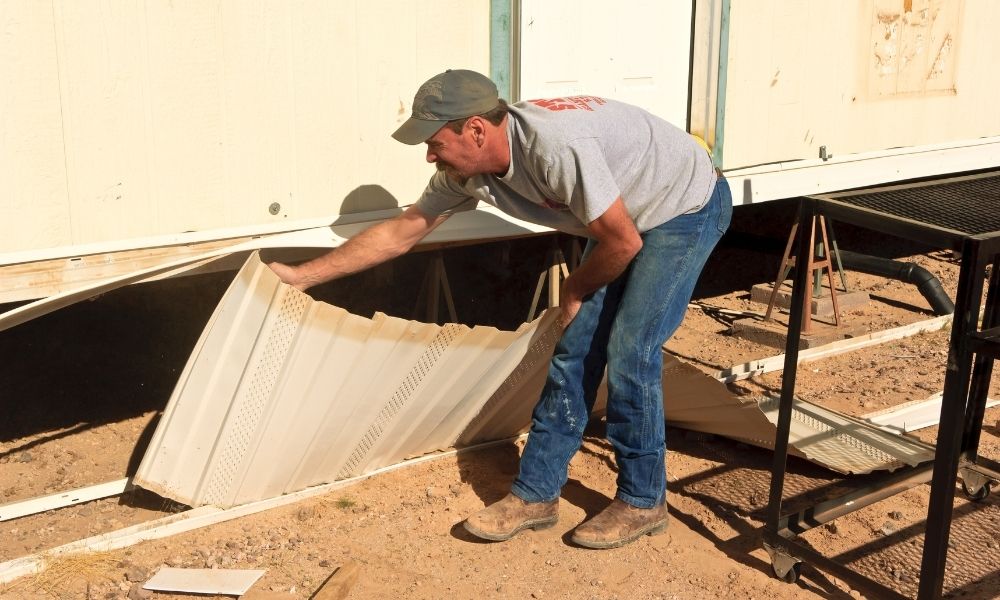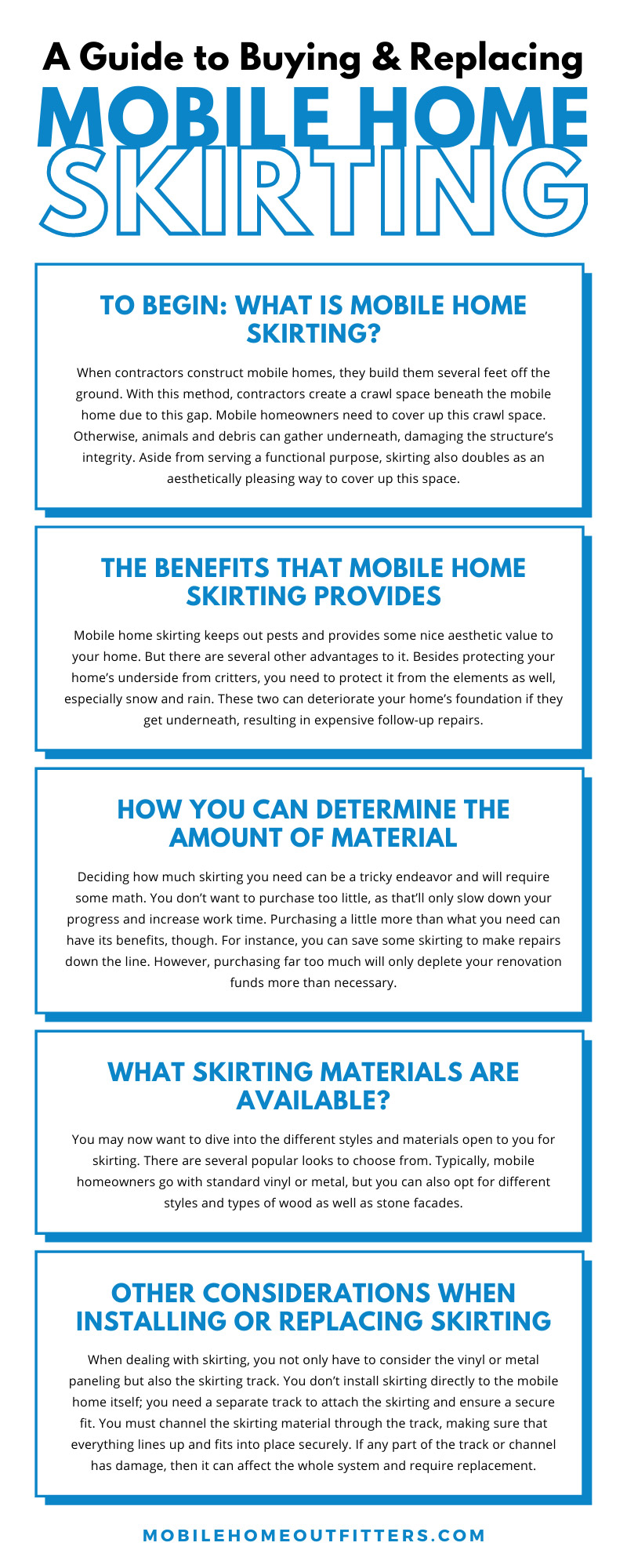
When the time comes to remodel your mobile home or make some necessary repairs due to aging materials, make sure you know what the job calls for. With mobile homes, one of the most important aspects to look out for is the skirting (also commonly referred to as “underpinning”) that covers your home’s foundation.
Installing and taking care of your home’s skirting is a necessary part of owning a mobile home. But you must make some key considerations before committing to any renovations. To help you in this process, we’ve created a guide to buying and replacing mobile home skirting.
Going in with an idea of what you need can speed the process up. It benefits work speed and ensures you have the best materials for the job. Know what you need and the benefits of improving your home’s skirting.
To Begin: What Is Mobile Home Skirting?
Mobile homes and manufactured homes don’t rely on a typical concrete foundation like a standard “stick-built” home does. When contractors set up mobile homes, they typically set them several feet off the ground using a foundation system made of steel piers (more common in the Western US) or concrete blocks (more common in the Eastern US). This installation method creates a crawl space beneath the mobile home to allow access to the plumbing, HVAC ductwork, and other key home systems.
Once the home setup is complete, mobile homeowners must cover up this crawl space. Without skirting, the structure will not only be less energy efficient, but its key systems will be exposed to damage from the elements, debris, and intrusive animals looking for shelter. Aside from serving this functional purpose, skirting also doubles as an aesthetically pleasing way to cover up this crawl space.
Although we’ve seen some customers use sheet metal or concrete- or stone-based material, the most common mobile home skirting product comes in the form of heavy-duty vinyl sheets cut down to size on the job site (depending on how high the home is off the ground). This material is simple to work with and easily accommodates homes with variability in how high they are off the ground at different points along their perimeter.
The Benefits That Mobile Home Skirting Provides
As mentioned, mobile home skirting, or underpinning, will protect your home from the elements and pesky animals while also providing some nice aesthetic value to your home. Without it, the structure is vulnerable to plumbing and HVAC damage and can begin to incur high energy bills from the resulting inefficiency.
That said, it’s important to know that skirting doesn’t just keep out the elements. It also allows air to pass through your mobile home’s crawl space. This airflow is crucial for mitigating mold growth and stopping harmful bacteria from proliferating beneath your home. You may still need to clean your home’s crawl space occasionally (especially if you live in a very humid climate), but the natural airflow will cut down the frequency of cleanings. For this reason, we always recommend either purchasing at least some vented skirting panels when purchasing materials for this project.
Skirting can also provide some insulation value to the home. Please note that this isn’t as applicable with standard vinyl skirting, which offers protection but doesn’t truly act as an insulation barrier. However, there are a number of insulated skirting products on the market today that specifically provide insulation protection for essential pipes and plumbing parts during colder months. Rapidwall and Titan Xterior Elite are a couple of examples. Essentially, insulated skirting will keep your home warmer during colder seasons, decreasing your heating bill and ensuring your pipes don’t suffer from expansion and contraction due to shifting temperatures. You may live in a harsh weather environment that sees low temperatures in the winter months (common in the Western United States, the Midwest, and the Northeast). If so, insulated skirting is a worthy and often necessary investment.
How You Can Determine the Amount of Material
Deciding how much skirting you need can be a tricky endeavor and will require some math. You don’t want to purchase too little, as shipping this material can be costly, and you only want to pay for it once. While you also don’t want to grossly over-purchase materials, buying a little more than you need can have its benefits. In fact, we typically recommend doing so. It’s very handy to have an additional panel or two and some extra trim if you have to make a patch repair down the road.
Determining the amount of skirting material necessary for your project will require you to take several measurements. First, you’ll need to calculate the circumference of your home by adding the length and width measurements (in feet). Be sure to also include any additional length of your home that needs skirting, such as an adjoining deck, bump out, or addition. You’ll also need to determine the average height of your home. This is easy if your home is on a level surface, such as a concrete pad.
However, if your home is on a sloped surface, you’ll need to take multiple height measurements around the home’s perimeter. We recommend that you measure the height of the home at each of its four corners and the middle part of each long side. For double- or triple-wide homes, it helps to take more measurements. To get the average height, add all your height measurements together to get a total, then divide by the number of measurements you took to get the average.
Once you have these measurements, there’s still quite a bit of math necessary to know how much material you’ll need for your project. This is why we’ve developed a Skirting Kit Configurator to help eliminate errors and make this process more straightforward. Once you input the measurements previously gathered into this mobile home skirting calculator, it’ll determine the number of skirting panels and trim kits you need and let you select the style and color you prefer. Be sure to check your measurements, though. As the old saying goes, “Measure twice and cut once.”
What Skirting Options Are There?
Now, let’s look at the different skirting options you can choose from for your project. While there are several different materials you can use to skirt your mobile home, the most common choice on the market today is heavy-gauge vinyl. Unlike corrugated metal, fiber-cement siding, and stone veneer products, vinyl is easy to transport, simple to install, and cost-effective.
At Mobile Home Outfitters, we carry a wide variety of styles and colors to suit your budget and design preferences. Whether you’re looking for the most cost-effective option, improved curb appeal, or greater energy efficiency, we have the skirting options you need.
Skirting Trim, Explained
When installing new skirting, you have to consider the paneling itself, but you also need to replace the skirting trim. Skirting trim kits include the top front and top back trim pieces. These two pieces snap together and “sandwich” the top of the skirting panel into place. These kits also have the bottom channel, which secures the bottom of the panel into place at ground level. The top back trim screws directly into the home’s exterior (typically just beneath the siding of the home) and is usually the first component you install. The top front trim piece snaps into the top back trim, providing a secure fit for the skirting panel in between, and you usually install it at the very end.
Do not screw the top back trim too snugly to your home. It’s important to leave a slight gap to allow the vinyl material room to expand and contract when temperatures vary. This will prevent the vinyl from cracking in cold temperatures. The bottom channel is typically the second installed component and is where the bottom of the skirting panels fit. Eight-inch nails known as “gutter spikes” (when installed into a soil or other natural surface) usually secure the bottom channel. But you can also adhere them using a strong adhesive product like Liquid Nails (called this when installed onto a concrete surface).
Get Your Skirting Project Underway
Miscalculating the amount of skirting you need or neglecting an important step in the installation process can significantly affect your productivity and may lead to installation issues down the line. We hope this guide to buying and replacing mobile home skirting helps streamline your renovation project. If you still have questions or want to talk through your project in greater detail, we can help. Our team can ensure you have what you need to make your project a successful one. Call us today at 888-MHO-SRVC (888-646-7782).


